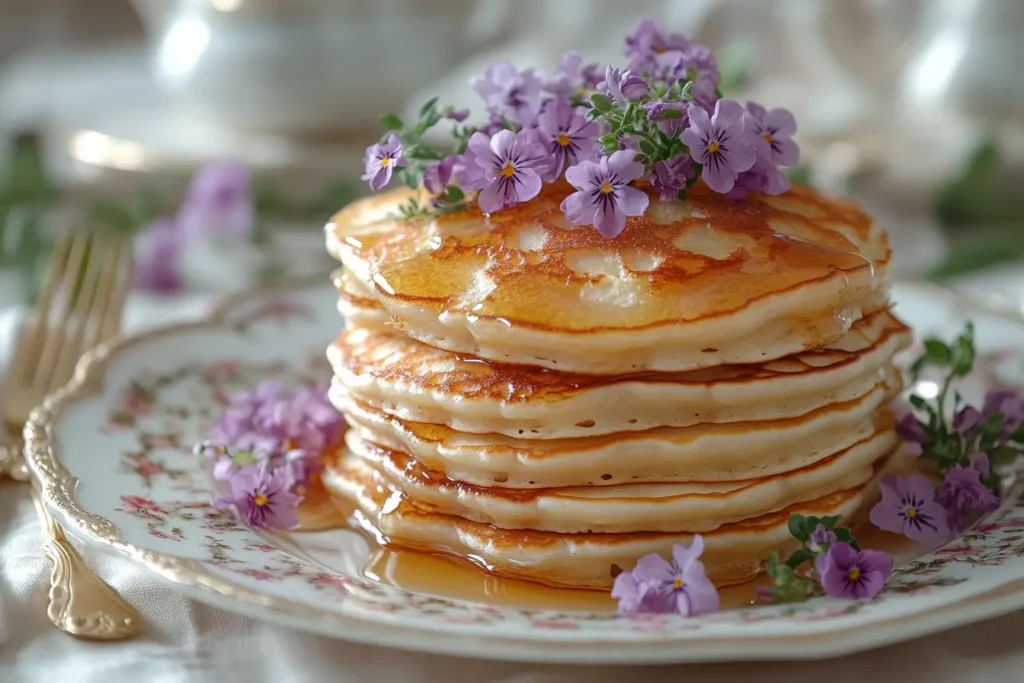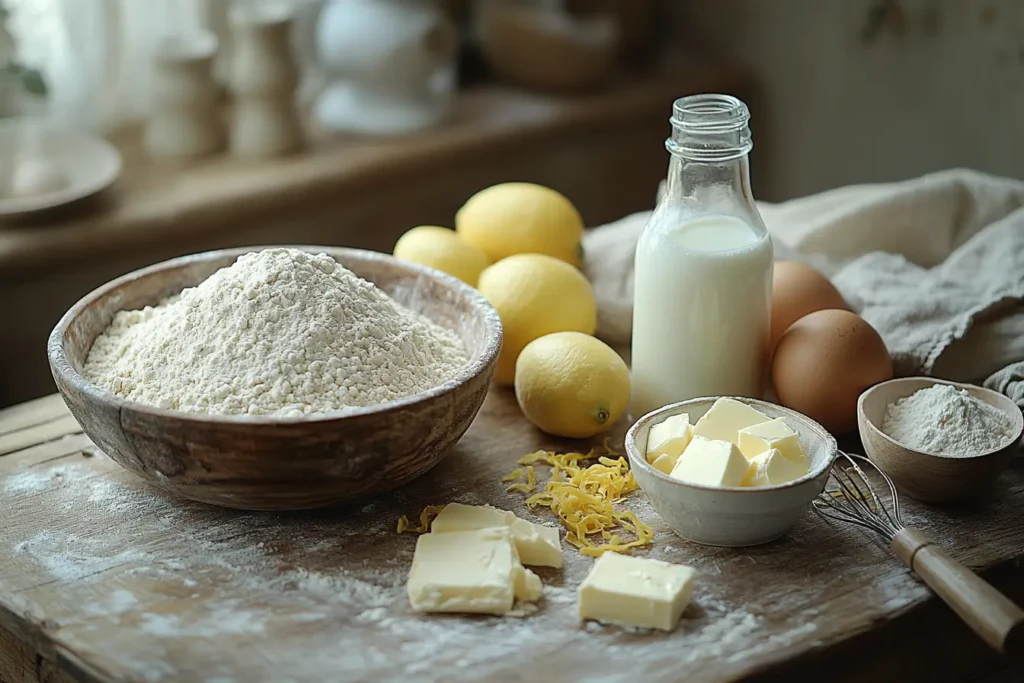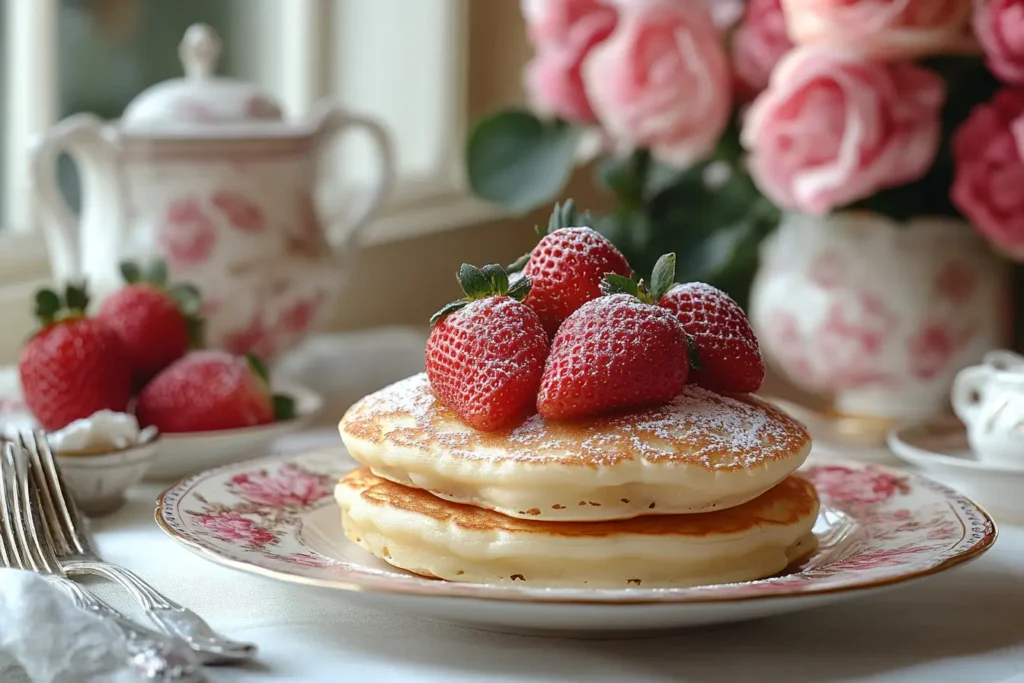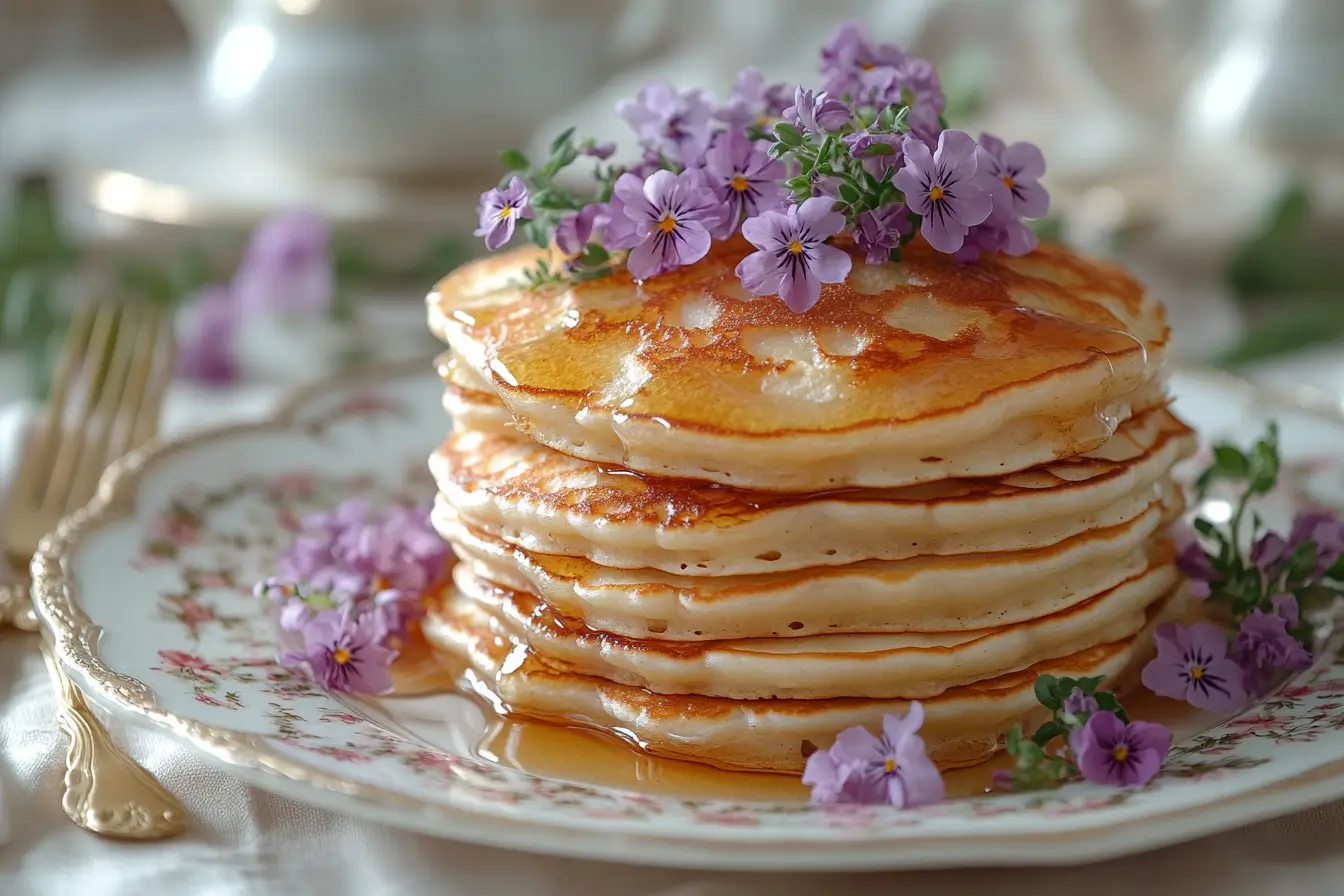
Introduction to Queen Elizabeth Pancakes
What Are Queen Elizabeth Pancakes?
Let’s talk pancakes—specifically, Queen Elizabeth pancakes. Unlike your run-of-the-mill Sunday brunch pancakes, these are rich, flavorful, and laced with just the right amount of history, making every bite feel like a royal occasion. In fact, they can be thought of as the royal family’s secret to adding flair to a traditional dish.
So, if you’ve ever wondered what makes these pancakes different, here’s a hint: it’s all in the ingredients and preparation. Moreover, with a touch of elegance and a respectful nod to tradition, these pancakes are worth every bit of effort. As a result, they stand out as a unique and regal addition to any breakfast table.
The History Behind Queen Elizabeth Pancakes
Why are these pancakes called Queen Elizabeth pancakes? They trace their roots back to the kitchens of Buckingham Palace. Stories suggest that during her reign, Queen Elizabeth II enjoyed pancakes on select occasions, made with ingredients reflecting her personal taste for subtly sweet and refined dishes.
Why Are They Special?
Here’s the thing: not every pancake earns the title “royal.” These pancakes are special because of their unique texture—a harmonious blend of fluffiness and crisp edges. Add to that a hint of citrus or delicate spices, and you’ve got a dish fit for a queen.
Ingredients for Queen Elizabeth Pancakes

Key Ingredients You’ll Need
To get started, you’ll need some staples from your pantry, plus a few extras to make them extraordinary. Here’s your list:
- All-purpose flour: The foundation of your batter.
- Eggs: For richness and structure.
- Milk: Adds moisture and ensures a smooth batter.
- Butter: Because everything’s better with butter!
- Sugar: A touch of sweetness, but not too much.
- Lemon zest: For that refreshing royal twist.
- A pinch of salt: Balances the flavors.
- Baking powder: Your secret to fluffy pancakes.
Alternatives for Healthier Pancakes
If you’re watching your calories or catering to dietary restrictions, don’t worry. You can substitute:
- Whole wheat flour or almond flour for all-purpose flour.
- Plant-based milk like almond or oat milk.
- Coconut sugar or honey instead of regular sugar.
Special Ingredients for Authentic Flavor
If you want to make your pancakes truly unforgettable, consider adding a dash of vanilla extract or even a sprinkle of nutmeg. Not only do these subtle flavors enhance the overall taste, but they also add a layer of depth without overpowering the pancake’s delicate essence. Furthermore, these small additions can transform an ordinary pancake into an extraordinary culinary experience. As a result, your guests or family will be asking for seconds, and you’ll have a new breakfast favorite in your repertoire.
Essential Kitchen Tools
Must-Have Equipment for Pancake Perfection
Before you dive into the recipe, make sure your kitchen is stocked with these tools:
- A mixing bowl: For combining your ingredients.
- A whisk: Ensures a lump-free batter.
- A non-stick skillet or griddle: For even cooking.
- A spatula: Because flipping pancakes is an art!
Optional Tools for Easier Preparation
If you’re aiming for a pro-level experience, consider using:
- A ladle or pancake dispenser for even portions.
- A microplane for zesting lemons.
Step-by-Step Instructions for Making Queen Elizabeth Pancakes
Preparing the Batter
The magic of these pancakes starts with the batter. Follow these steps to ensure it’s just right:
- Mix the dry ingredients: In a large bowl, whisk together flour, sugar, baking powder, and salt.
- Combine the wet ingredients: In another bowl, beat the eggs, then add milk, melted butter, and vanilla extract.
- Blend everything together: Gradually pour the wet ingredients into the dry ingredients, whisking until smooth. Don’t overmix—you want the batter to be slightly lumpy.
- Let it rest: Set the batter aside for 10 minutes. This step allows the ingredients to meld together, creating fluffier pancakes.
Cooking the Pancakes
Now, for the fun part—cooking! Here’s how to do it like a pro:
- Heat your skillet over medium heat and grease it lightly with butter or oil.
- Pour about 1/4 cup of batter onto the skillet for each pancake.
- Cook until bubbles form on the surface and the edges look set—about 2-3 minutes.
- Flip the pancake gently and cook the other side for another minute or so until golden brown.
“The secret to a perfect pancake flip? Confidence! Hesitation will only lead to a messy batter splatter.” 😉
Achieving the Perfect Texture and Flavor
Here’s a tip: Adjust the heat if your pancakes are browning too quickly. Low and steady wins the race—just like the patience Queen Elizabeth likely demonstrated during her long reign! 🥞
Common Problems and Their Solutions
Batter Too Thick or Too Thin
Finding your batter consistency off? If it’s too thick, add a splash of milk. Too thin? A spoonful of flour will do the trick.
Pancakes Sticking to the Pan
If your pancakes are clinging to the skillet for dear life, the culprit might be insufficient greasing. A small pat of butter before each batch can save the day.
Uneven Cooking and Burning
To avoid unevenly cooked pancakes, make sure your skillet is evenly heated before adding batter. And remember, medium heat is your best friend.
“Think of your skillet as a dance floor—too hot, and the pancakes burn; too cold, and they don’t shine.” 💃
Tips and Tricks for the Best Queen Elizabeth Pancakes
Secrets to a Fluffy Pancake
Making pancakes fluffy can feel like magic, but it’s all about science. Want the fluffiest pancakes ever? Here’s the scoop:
- Mind the mixing: Overmixing the batter is a no-go. Those lumps in your batter? They’re not flaws—they’re pockets of fluffiness waiting to happen.
- Let it rest: A short nap for the batter (10–15 minutes) allows the baking powder to activate, creating bubbles that give the pancakes their lift.
- Don’t skimp on the baking powder: If your baking powder is outdated, your pancakes might end up flat. Always check the expiration date.
“The fluffiest pancakes come to those who wait (and whisk wisely)!” 🥞
How to Add a Royal Touch to Your Pancakes

If you’re aiming for a meal fit for a queen, remember that presentation is everything. To truly impress, here are a few ways to add that royal sparkle:
First, serve with finesse by stacking your pancakes high and topping them with edible flowers or gold-dusted powdered sugar for an elegant and regal effect. Additionally, consider going citrusy by adding a drizzle of lemon-infused honey, which provides a luxurious and refreshing touch. Lastly, plate like a pro by using fine china or a wooden platter, as this simple step can instantly elevate the entire dining experience.
Pairing Queen Elizabeth Pancakes with Toppings and Drinks
Best Toppings to Elevate the Flavor
What’s a pancake without toppings? Here’s how to take yours to the next level:
- Fresh fruit: Strawberries, blueberries, or slices of pear add natural sweetness.
- British classics: Try clotted cream and a spoonful of strawberry jam for an authentic touch.
- Decadent options: Whipped cream and chocolate shavings create a dessert-like experience.
Perfect Beverage Pairings
Complement your pancakes with these beverages to make the meal truly special:
- Earl Grey tea: The citrus notes pair beautifully with the lemon zest in the pancakes.
- Hot chocolate: For a cozy morning, there’s nothing better than sipping cocoa alongside fluffy pancakes.
- Sparkling water with mint: Refreshing and light, perfect for balancing out the richness.
“Pancakes and tea? That’s not just breakfast—that’s an event!” ☕
The Cultural Significance of Pancakes in Royal Cuisine
Pancakes in British Culinary Traditions
Pancakes have been a beloved staple of British kitchens for centuries, with traditions like Shrove Tuesday (or Pancake Day) showcasing their importance. On this day, people whip up pancakes to use up rich ingredients before Lent, symbolizing indulgence and simplicity.
How Queen Elizabeth Popularized This Dish
Although pancakes have long been a British favorite, Queen Elizabeth’s refined palate brought a sophisticated twist to this classic dish. The royal version emphasizes subtle flavors, elegant presentation, and a nod to traditional values.
“Pancakes may be humble, but when the Queen enjoys them, they’re elevated to a royal status!” 👑
Variations of Queen Elizabeth Pancakes Around the World
Regional Twists and Modifications
Pancakes may have British origins, but their influence has undeniably spread far and wide. Moreover, different regions have added their unique twists to this classic dish.
For instance, American-style pancakes are made with a touch of buttermilk, which adds extra tanginess to the flavor. Additionally, they are often served with a dollop of whipped butter, making them a favorite for hearty breakfasts. On the other hand, French crêpes are thinner and more delicate, making them perfect for rolling with sweet fillings like Nutella or lemon sugar. Furthermore, Dutch pancakes (Poffertjes) are tiny, fluffy delights that are typically served with powdered sugar and butter, adding a charming bite-sized twist to the pancake tradition.
As a result, no matter where you are in the world, pancakes remain a versatile and beloved treat.
Gluten-Free and Vegan Versions
For those with dietary restrictions, you can easily adapt Queen Elizabeth pancakes without sacrificing flavor.
For a gluten-free option, you can use almond flour or a gluten-free flour blend, which ensures the pancakes remain fluffy and delicious. Additionally, for a vegan version, you can replace eggs with flaxseed gel (made by mixing 1 tablespoon of flaxseed with 2.5 tablespoons of water per egg). Furthermore, swapping regular milk for plant-based alternatives, such as almond or oat milk, works wonderfully to maintain the pancake’s creamy texture. As a result, these simple substitutions make it possible for everyone to enjoy this royal treat, regardless of dietary needs.
“Inclusivity is the secret ingredient that makes every pancake plate special!” 🥄
Common Pancake Problems and How to Fix Them
Why Does the Batter Clump Up?
Clumpy batter can happen when dry and wet ingredients aren’t mixed evenly. To fix this, whisk the dry ingredients separately before combining them with the wet mixture.
Why Are My Pancakes Sticking to the Pan?
Sticky situations occur when the skillet isn’t hot enough or isn’t greased properly. Heat the pan to medium and coat it lightly with butter or oil before pouring the batter.
Why Are My Pancakes Too Thin or Too Thick?
The consistency of the batter matters:
- If too thin: Add a tablespoon of flour and mix gently.
- If too thick: Thin it out with a splash of milk until it reaches the right pourable texture.
Additional Tips for Pancake Perfection
- Test your heat: Before pouring batter, drop a tiny bit of water on the skillet. If it sizzles and evaporates, you’re good to go.
- Consistency is key: Use a ladle or pancake dispenser to ensure uniform size.
- Experiment: Add a pinch of cinnamon or cardamom for a warm, spicy kick.
“Remember, every pancake flip is a chance to achieve greatness.” 🔄
Common Pancake Problems and How to Fix Them
Why Does the Batter Clump Up?
Clumps in your batter usually mean the dry ingredients weren’t sifted or mixed thoroughly before combining them with the wet ones. A quick fix? Whisk the dry ingredients separately beforehand. If the batter is already mixed, strain it lightly with a fine sieve.
Why Are My Pancakes Too Dense?
Ever feel like your pancakes weigh more than they should? That could be from overmixing or not incorporating enough leavening agents like baking powder. Interestingly, adding an extra egg to pancake mix can enhance the structure and provide a lighter texture.
Why Are My Pancakes Sticking to the Pan?
Sticking can be a sticky problem—pun intended. Use a well-seasoned skillet, ensure even greasing, and check your heat. Pancakes cook best on medium heat; too hot, and they’ll burn before releasing from the pan.
Additional Tips for Pancake Perfection
- Experiment with Flavors: Add a dash of cinnamon or cardamom to elevate the flavor.
- Serve Creatively: Pancakes pair wonderfully with other breakfast staples, such as a pancake breakfast casserole.
- Know Your Pancake Pan: Non-stick surfaces and cast iron skillets offer the best results for even cooking.
“Every pancake is an opportunity to turn breakfast into a work of art!” 🥞
Conclusion: Why Queen Elizabeth Pancakes Deserve a Place on Your Table
Making Queen Elizabeth pancakes isn’t just about food; rather, it’s about creating a meaningful connection with history, tradition, and royal elegance. These pancakes are perfect for a wide range of occasions, whether it’s a casual family brunch or a sophisticated gathering with friends. Moreover, their rich, flavorful layers and soft, delicate texture make them an unforgettable treat. Above all, they bring a sense of refinement to your breakfast table, ensuring every bite feels like a royal indulgence. Therefore, if you’re looking to elevate your mornings, these pancakes are undoubtedly the way to go.
Pair these pancakes with expertly crafted casseroles or your favorite morning beverages, and you’ve got a meal fit for royalty. Whether you’re cooking for yourself or sharing with loved ones, Queen Elizabeth pancakes will undoubtedly impress.
“If breakfast is the most important meal of the day, why not make it the most royal too?” 👑

